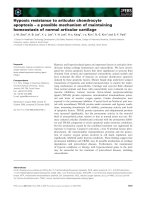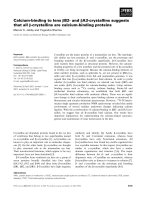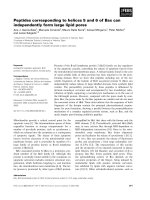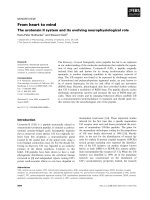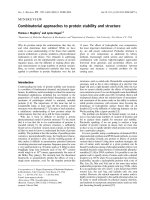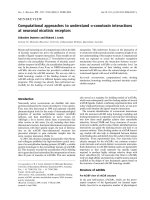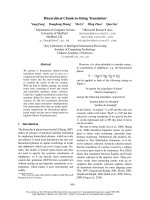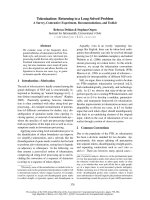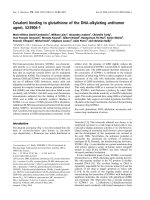báo cáo khoa học: " Implementing telehealth to support medical practice in rural/remote regions: what are the conditions for success?" ppsx
Bạn đang xem bản rút gọn của tài liệu. Xem và tải ngay bản đầy đủ của tài liệu tại đây (278.07 KB, 8 trang )
BioMed Central
Page 1 of 8
(page number not for citation purposes)
Implementation Science
Open Access
Research article
Implementing telehealth to support medical practice in
rural/remote regions: what are the conditions for success?
Marie-Pierre Gagnon*
1,2
, Julie Duplantie
1
, Jean-Paul Fortin
3
and
Réjean Landry
4
Address:
1
Evaluative Research Unit, Quebec University Hospital Centre, Quebec, Canada,
2
Department of Family Medicine, Laval University,
Quebec, Canada,
3
Department of Social and Preventive Medicine, Laval University, Quebec, Canada and
4
Department of Management, Laval
University, Quebec, Canada
Email: Marie-Pierre Gagnon* - ; Julie Duplantie - ; Jean-
Paul Fortin - ; Réjean Landry -
* Corresponding author
Abstract
Background: Telehealth, as other information and communication technologies (ICTs) introduced to
support the delivery of health care services, is considered as a means to answer many of the imperatives
currently challenging health care systems. In Canada, many telehealth projects are taking place, mostly
targeting rural, remote or isolated populations. So far, various telehealth applications have been
implemented and have shown promising outcomes. However, telehealth utilisation remains limited in
many settings, despite increased availability of technology and telecommunication infrastructure.
Methods: A qualitative field study was conducted in four remote regions of Quebec (Canada) to explore
perceptions of physicians and managers regarding the impact of telehealth on clinical practice and the
organisation of health care services, as well as the conditions for improving telehealth implementation. A
total of 54 respondents were interviewed either individually or in small groups. Content analysis of
interviews was performed and identified several effects of telehealth on remote medical practice as well
as key conditions to ensure the success of telehealth implementation.
Results: According to physicians and managers, telehealth benefits include better access to specialised
services in remote regions, improved continuity of care, and increased availability of information.
Telehealth also improves physicians' practice by facilitating continuing medical education, contacts with
peers, and access to a second opinion. At the hospital and health region levels, telehealth has the potential
to support the development of regional reference centres, favour retention of local expertise, and save
costs. Conditions for successful implementation of telehealth networks include the participation of
clinicians in decision-making, the availability of dedicated human and material resources, and a planned
diffusion strategy. Interviews with physicians and managers also highlighted the importance of considering
telehealth within the broader organisation of health care services in remote and rural regions.
Conclusion: This study identified core elements that should be considered when implementing telehealth
applications with the purpose of supporting medical practice in rural and remote regions. Decision-makers
need to be aware of the specific conditions that could influence telehealth integration into clinical practices
and health care organisations. Thus, strategies addressing the identified conditions for telehealth success
would facilitate the optimal implementation of this technology.
Published: 24 August 2006
Implementation Science 2006, 1:18 doi:10.1186/1748-5908-1-18
Received: 12 June 2006
Accepted: 24 August 2006
This article is available from: />© 2006 Gagnon et al; licensee BioMed Central Ltd.
This is an Open Access article distributed under the terms of the Creative Commons Attribution License ( />),
which permits unrestricted use, distribution, and reproduction in any medium, provided the original work is properly cited.
Implementation Science 2006, 1:18 />Page 2 of 8
(page number not for citation purposes)
Background
Telehealth is considered a major innovation at the techno-
logical, social, and cultural levels[1]. This technology has
the potential to increase access to, and quality of, health
care services and to lower health system expendi-
tures[2,3]. Thus, introducing telehealth as a tool to sup-
port the delivery of health care services implies numerous
changes for providers, organisations, and the health sys-
tem as a whole that must be accounted for during the
implementation process[4].
According to systematic reviews[2,3,5,6], evidence of tele-
health benefits has been reported for various applications
such as teleradiology, telepsychiatry, transmission of
echocardiograms, teledermatology, and telehomecare.
Results from a majority of the reviewed studies support
telehealth over other traditional modes of health services
delivery. Other studies have reported telehealth benefits
with respect to continuity of patient care and coordina-
tion of clinical activities between various health care
organisations and levels of care [7-10].
For rural, remote or isolated regions, telehealth is consid-
ered as a tool that could exert a positive impact on several
dimensions of health care services delivery. For instance,
telehealth can support the delivery of specialised services
in a timely fashion for remote populations, facilitate
access to education for clinicians, and save travel costs for
patients and professionals. Moreover, as telehealth tech-
nologies become more integrated into the health care sys-
tem, they could increasingly contribute to the
reorganisation of medical workforce supply and exert a
profound influence on physician practice, especially in
remote areas[11].
Successful telehealth implementation represents the first
step towards the normalisation of this technology as a
means of health care delivery. According to May et al[12],
normalisation is "the move toward the routinized embedding
of telemedicine in everyday clinical practice" (p.596). Never-
theless, telehealth implementation still faces major barri-
ers, mostly related to structural, organisational, and
professional imperatives[4,13]. Specifically, structural
barriers relate to licensure, reimbursement, policies gov-
erning telecommunication and information technologies
development, and interjurisdictional collabora-
tions[14,15]. Issues regarding health care organisations
are also of paramount importance to ensure telehealth
adoption. The introduction of a new technology chal-
lenges existing structural and operational features and a
mutual adjustment is often required between the technol-
ogy and the organisation[16,17]. Additionally, physicians
represent one of the main groups of telehealth users and
the introduction of this technology into their practice is
affected by particular characteristics of the medical profes-
sion[18]. Furthermore, telehealth adoption by an individ-
ual is considered as a complex behaviour determined by a
large set of psychosocial factors[19,20].
Knowledge is still limited with respect to the specific
impacts of telehealth on the practice of health care profes-
sionals in rural and remote regions. A recent survey found
no direct effects of telehealth on recruitment and reten-
tion of physicians in a rural area of Canada[21]. Nonethe-
less, this study indicated that rural physicians who used
telehealth had a more positive perception of the value of
this technology for their community. A study conducted
among medical residents in Quebec found a significant
correlation between residents' positive evaluation of tele-
health and their intention to practice in a remote
region[22]. However, given the complex and multiple
influences on physicians' choice of practice location, it
remains difficult to assess the specific contribution of tel-
ehealth on medical practice in rural and remote regions.
Telehealth benefits seem obvious for large territories with
relatively dispersed population such as rural and remote
regions of the Province of Quebec (Canada). Several tele-
health projects have been implemented in Quebec over
the last decade. Eastern Quebec was one of the first region
to participate in telehealth demonstration projects, with
the Réseau de Télémédecine de l'Est du Québec (Eastern Que-
bec Telemedicine Network: teleradiology and telecardiol-
ogy), Projet de Démonstration de la Télésanté aux Iles-de-
la-Madeleine (Magdalene Islands Telehealth Demonstra-
tion Project: multiple applications) and the Réseau Québé-
cois de Télésanté de l'Enfant (Quebec Child Telehealth
Network: paediatrics telecardiology). Evaluations of these
projects have generally reported a positive impact on sev-
eral factors related to the quality of clinical practice and
the continuity of patient care in rural, remote or isolated
regions [23-25]. However, these three projects failed to
normalise in their initial form.
The reasons that may explain why most telehealth appli-
cations have failed to normalise in Quebec may be similar
to those reported in other settings[12]. First, most were
small scale demonstration or pilot projects that aimed to
establish feasibility, safety, effectiveness, and conditions
of use for an eventual diffusion of telehealth. In these
projects, several telehealth applications were tested that
formed a complex system of interactions between tech-
nologies, functionalities, information workflow, and
users[25].
Second, telehealth projects are complex, innovative, con-
stantly evolving, and many of their effects cannot neces-
sarily be anticipated, which is then a challenge for the
evaluation of their various impacts on the health care sys-
tem[12,26]. Moreover, high quality evidence on 'what
Implementation Science 2006, 1:18 />Page 3 of 8
(page number not for citation purposes)
works' from well-designed experimentations such as ran-
domised controlled trials (RCT) is not always sufficient to
set up policies. Knowledge on the specific conditions that
lead to telehealth normalisation in a given context ('how
it works') is also essential[13]. Finally, evidence about glo-
bal impacts of telehealth on health care professionals'
work as well as on the recruitment and retention of med-
ical workforce in remote regions is lacking.
Nevertheless, the Quebec Ministry of Health has identi-
fied telehealth as one of the means to counterbalance the
uneven distribution of the medical workforce in the Prov-
ince and an essential component of the reorganisation of
health services[27]. Many telehealth projects are currently
ongoing in Quebec, but telehealth is still not integrated as
a routine service in the health care system.
In order to better understand the conditions promoting or
limiting telehealth integration, this study explored tele-
health's effects on several dimensions related to the prac-
tice of health care professionals in rural and remote
regions of Quebec. Decision-makers were involved in the
different phases of the research project in order to facili-
tate knowledge sharing and utilisation. A qualitative field
study was conducted in four regions of Eastern Quebec to
identify the perceptions of physicians and managers
regarding telehealth benefits and limitations as well as the
key conditions for successful telehealth implementation.
Methods
Selection of respondents
A purposive sampling technique was used to identify
potential respondents[28]. In order to ensure both diver-
sity of opinions and relevance to the topic of interest,
selection criteria included: localisation, profession (clini-
cian or manager), medical speciality, and telehealth expe-
rience (extensive or limited). The four regions of Eastern
Quebec were chosen because of their involvement in pre-
vious telehealth experimentations, especially in teleradi-
ology and telecardiology. Thus, professionals and
managers of these regions were more knowledgeable
about telehealth and its effects. These regions also com-
bined various practice settings: urban hospitals, semi-
urban hospitals, and rural and remote health centres.
Initial subjects were identified through personal contacts
from members of the research team, lists of telehealth
conference participants, and documentation on tele-
health projects. Other potential respondents were identi-
fied through the snowball method which solicits referrals
from initial participants to generate additional sub-
jects[29]. Some medical specialists such as radiologists,
cardiologist and paediatricians had experience in tele-
health activities. Other respondents only used it for tele-
education or meetings, whereas some respondents never
used telehealth at all. Principles of data saturation and
information redundancy were applied to determine sam-
ple size, i.e. the recruitment of participants ended when
additional interviews did not bring new information or
opinion[30].
Development of the survey instrument
Interview schemas were elaborated from the literature and
previous research done by the team[16,19,25]. A different
schema was prepared for clinicians and managers. These
schemas were pre-tested with four collaborators of the
research team who had medical and/or management
backgrounds.
The interview schema for physicians was divided into
three parts. The first part comprised questions about
actual practice, motivations for practicing in the remote
region, motivations for staying in the region, as well as
potential factors that could make one leave the region.
The second part dealt with the quality of life at work and
the effects of telehealth on clinical practice. If respondents
did not have access to telehealth, perceptions concerning
its possible applications to their practice were gathered.
The last part of the interview covered perceptions about
the benefits and limitations of telehealth use in one's
practice as well as the conditions that would facilitate tel-
ehealth integration into clinical work.
Managers from hospitals and health regions were also
interviewed about the nature of their work and the strate-
gies they were using to attract and keep medical workforce
in the region. Managers were also asked questions dealing
with the effects of telehealth on clinical practice and
organisation of care. Finally, questions addressed their
opinion about telehealth benefits and limitations, as well
as their perceptions about requirements to ensure tele-
health integration.
Data collection procedures
A research professional contacted potential respondents
by telephone to present the study and to solicit their par-
ticipation in an interview. For logistic reasons, interview
scheduling was limited and potential respondents had to
be available on the day planned for the visit to their cen-
tre. Those who were interested and available received a
copy of the schema by electronic mail during the week
prior to interview.
Written consent was obtained from all respondents prior
to interview. Interviews lasted from 20 minutes to one
hour. For logistic purposes, some interviews were con-
ducted in small groups of two to five persons. All inter-
views were tape-recorded with the consent of respondents
and a verbatim transcript was made. Two researchers
trained in social and health sciences conducted the inter-
Implementation Science 2006, 1:18 />Page 4 of 8
(page number not for citation purposes)
views and gathered observation notes. This material was
used together with interviews content for analyses.
Data analysis
A qualitative iterative strategy was adopted for data analy-
sis, based upon the method proposed by Huberman and
Miles[31]. In a first step, all interview transcripts and field
notes were read to extract general impressions and prelim-
inary classification categories. Seven broad categories
were created: 1) recruitment factors; 2) retention factors;
3) quality of life at work; 4) telehealth benefits; 5) tele-
health limitations; 6) conditions for telehealth integra-
tion; and 7) potential impact of telehealth on recruitment
and retention. In a second step, two researchers classified
interview content into matrixes corresponding to these
categories. Using an iterative approach, emerging patterns
and themes were identified within each category and dis-
cussed between the researchers. After a consensus on cod-
ing themes, content was independently coded by the two
researchers. Analyses were then compared and adjusted
after a consensus discussion with the research team.
To assess divergences and convergences between physi-
cians' and managers' views, as well as to gain an overview
of the qualitative material, the weight of each theme was
assessed by the frequency of its being mentioned. Only
themes mentioned by three respondents or more were
considered in this analysis. Aspects related to physician
recruitment and retention are beyond the scope of this
article; only findings related to perceptions about tele-
health benefits and limitations, as well as conditions to
facilitate telehealth integration into practices are pre-
sented and discussed below.
Ethical approval
The study received approval from the ethics committee of
the Quebec University Medical Centre.
Results
A total of 40 physicians and 14 managers were inter-
viewed.
Perceived telehealth benefits
For a majority of physicians and managers, telehealth was
perceived as a powerful tool to improve healthcare serv-
ices for populations living in remote areas. According to
respondents, telehealth has the potential to facilitate
access to, and availability of, services that would be diffi-
cult to obtain otherwise. As shown in Table 1, many
respondents agreed that telehealth implementation has
brought specialised services to patients close to their
home and that many transfers were avoided, saving signif-
icant travel costs for patients and their family. Moreover,
respondents have reported that telehealth could be help-
ful to transmit information before transferring a patient to
an urban centre, thus facilitating case management. Tele-
health is also viewed as an efficient means to perform fol-
low-up visits in order to improve continuity of care. In
some cases, telehealth can also allow a first evaluation of
a remote patient by a visiting specialist: "There's a paediat-
ric specialist who comes only once a year and he asked to use
telemedicine for his first evaluation of a new patient so that his
visit would be improved. That way he can operate kids who oth-
erwise would have to wait much longer." (Hospital manager,
region 10).
At the professional level, telehealth was perceived as an
excellent means of communication for remote physicians
by providing them with easy access to a second opinion
and contacts with their peers. Feelings of isolation are
Table 1: Perceived telehealth benefits and limitations
Dimension Perceived Benefits (Frequency)* Perceived Limitations (Frequency)*
Clinical/Patient care Access to specialised services (5 md, 9 hm)
Potential to save costs for patients (3 md, 4 hm)
Facilitates management of transfers (4 md)
Allows distant follow-up that improves continuity of care (3 md)
Improves information circulation (3 md)
Telehealth will never replace on site physician (6
md, 1 hm)
Professional Access to a second opinion (10 md, 2 hm)
Facilitates communication with peers (7 md, 3 hm)
Diminishes the feeling of isolation (3 md, 2 hm)
Anticipated changes in the definition of tasks and
responsibilities (2 md, 2 hm)
Educational Knowledge development and update (7 md, 2 hm)
Increases access to CME (4 md, 4 hm)
Multi-disciplinary/multi-centered exchanges (3 md)
Teleeducation cannot substitute for all CME
activities (2 md, 1 hm)
Organisational/Systemic Supports the hospital as a regional reference centre (6 md, 5 hm)
Ensures availability of services (4 md, 3 hm) Saves time and money
for meetings (4 md, 3 hm)
Potential to save costs for health system (3 md, 4 hm)
Better organisation of on-call duties (4 md)
Fear of replacing regional specialists (3 md, 2 hm)
Heavy logistics needed in the two sites (2 md, 2 hm)
Lack of commitment from the organisation (2 md, 1
hm)
* Number of physicians (md) and hospital managers (hm) who mentioned the item.
Implementation Science 2006, 1:18 />Page 5 of 8
(page number not for citation purposes)
common among remote physicians[32]. Thus, for a phy-
sician working in a remote region, telehealth could act as
a way to keep in touch with peers and colleagues from
other regions. Telehealth was also considered as an effi-
cient way to provide education and to facilitate exchanges
between professionals from various sites and specialties.
"It's more difficult to work with a remote specialist if you don't
know him or her. That's why we've asked for an affiliation with
another centre, like the one we have with [hospital's name]
through continuing medical education. We've asked to get 'live'
access to videoconferences from all over the province." (Medi-
cal specialist, region 09). Another telehealth benefit iden-
tified was the possibility to organise on-call duties on a
regional basis for specialties such as radiology. Thus,
instead of sharing the responsibility for on-call duties
between radiologists of a single hospital, telehealth could
allow a greater number of specialists from different cen-
tres to cover the whole region. "Six months ago, we began
regional on-call duty covering three hospitals of the region. We
are four radiologists who share the responsibility each week."
(Medical specialist, region 01).
Hospitals and health care centres located in remote
regions can also benefit from telehealth since it offers a
support to ensure the complete coverage of population
needs in terms of health care services. "With telehealth we
can have access to ultra specialised services without transferring
the patient. The idea is not transferring patients if we can offer
the service here. It doesn't make sense to transfer a patient only
for a diagnosis when it can be done remotely." (Hospital man-
ager, region 09). Hence, telehealth could allow for the
development of regional reference centres that would pro-
vide a wide range of services to remote populations. How-
ever, this situation could also create competition between
hospitals of a same region for obtaining the status of a
referral centre. Moreover, telehealth is believed to produce
significant savings for remote hospitals and for the health
care system. For instance, teleconference can be used to
attend administrative meetings, leading to substantial sav-
ings on travel costs. However, the redistribution of savings
between organisations and levels of care is an important
and complex issue.
Perceived telehealth limitations
As shown in Table 1, only few limitations were reported
with respect to the use of telehealth in remote regions. For
instance, physicians were concerned about the fact that
telehealth could replace onsite human resources.
Respondents also commented that some specialists would
prefer to stay in university centres and to provide services
via telehealth rather than moving to a remote region:
"Telemedicine could make people want to stay where they are,
in university centres, but it won't replace a radiologist in the
region, who can be in contact and play a different role as con-
sultant with other physicians." (Hospital manager, region
02). A similar fear was present that tele-education through
videoconference would replace all continuing medical
education (CME) activities outside the region. For remote
physicians, participation in scientific activities in urban
centres also represents an occasion to socialise with their
colleagues, which could never be replaced by teleconfer-
ences.
Perceived conditions for telehealth success
Physicians and managers were also asked to discuss the
conditions that could help telehealth integration into
their practice. Responses were classified into six dimen-
sions representing the levels at which efforts would be
needed to facilitate telehealth integration into practice.
These findings are presented in Table 2. At the individual
level, respondents agreed that telehealth should be easy to
use and compatible with daily practice. As one physician
Table 2: Conditions for telehealth implementation
Dimension Condition (Frequency)*
Individual Perceived ease of use (4 md, 3 hm) Technology integrated to the daily practice (3 md, 2 hm)
Healthcare professionals' motivation (2 md, 1 hm)
Professional System based on the needs of health care professionals (4 md, 3 hm) Adequate remuneration for professionals in both
sites (6 md, 1 hm)
Defining clear rules for professional liability (3 md, 2 hm) Participation of physicians in telehealth decision-making (3md)
Organisational Availability of resources dedicated to telehealth (specialised nurses, technicians, etc) (5 md, 4 hm)
Specific schedules for telehealth consultations (3 md, 6 hm)
Referrals based upon existing collaboration networks (3 md, 3 hm)
Availability of up-to-date equipment (2 md, 3 hm)
Socio-political/Systemic Massive investments in technologies and infrastructures (1 md, 4 hm)
Regional agreements and local development plans for health care services delivery based upon a combination of local
expertise, outreach services, and access to specialists with telehealth (1 md, 4 hm)
Technological Reliable, mobile, ergonomic, and user-friendly systems (4 md, 5 hm)
Image quality to allow diagnosis (4 md, 1 hm)
Ethical/Legal Ensuring data confidentiality (2 md, 2 hm)
* Number of physicians (md) and hospital managers (hm) who mentioned the condition.
Implementation Science 2006, 1:18 />Page 6 of 8
(page number not for citation purposes)
said: "The system must adapt to my practice and not vice-
versa." (Medical specialist, region 01).
Motivation of healthcare providers was also deemed
important to facilitate telehealth integration. A successful
telehealth network should be based upon clinicians'
needs and promote their participation in decision-mak-
ing. "We must be involved in the whole implementation proc-
ess." (General practitioner, region 10). This reflects a
bottom-up implementation strategy where end-users are
first consulted to identify their needs and expectations,
followed by an iterative approach where they are involved
in decisions at different stages of the project development.
Healthcare organisations also have an important role in
supporting telehealth integration. Human, material, and
logistical resources need to be provided to ensure the
functioning of telehealth services. Moreover, at the socio-
political level, it is important to secure financing for
equipment maintenance and upgrade. At the technologi-
cal level, the various components of telehealth systems
must correspond to users' expectations in terms of relia-
bility, ergonomics, mobility, and user-friendliness.
Finally, telehealth networks should assure the required
level of security in order to protect data confidentiality
and patient privacy.
Discussion
This study aimed to explore the potential of telehealth to
support medical practice in rural and remote regions, as
well as the conditions to ensure successful implementa-
tion of this technology into health care organisations. Tel-
ehealth shows several potential benefits for rural and
remote populations and could definitely improve patient
care as a result of increased accessibility to specialised
services, better continuity of care, and avoided transfers.
These findings confirm those reported in other telehealth
projects[3,6,25]. However, despite growing evidence of its
benefits, telehealth is not yet integrated as part of the eve-
ryday medical practice in the Quebec health care system.
Using the framework of telehealthcare normalisation pro-
posed by May et al[12], there are many conditions that
need to be addressed in order to facilitate telehealth inte-
gration into routine care.
First, remote and rural physicians are among the principal
telehealth users. It is thus important to emphasise tele-
health's benefits on the work of health care professionals.
Telehealth has the potential to improve work satisfaction
by providing easier access to continuing education and
facilitating contacts with colleagues. Access to CME has
been associated with higher satisfaction at work and better
quality of care[32] and could be a factor of physician
retention in rural and remote areas[33]. Such findings can
support decision-making with respect to the diffusion of
telehealth services in remote regions. However, there is
also a potential threat that telehealth would encourage
specialists to stay in urban centres while using telehealth
to provide coverage to remote regions. This has been
pointed out as a possible consequence of the diffusion of
teleradiology services[34].
Second, telehealth is also seen as a means to support the
organisation of health care delivery on a regional basis,
allowing greater access to specialised resources and better
distribution of on-call duties between physicians from a
whole region. Therefore, an indirect impact of telehealth
is an increased autonomy for rural and remote regions.
This could generate some tension between regions and
levels of care since specialised services could be directly
accessed via telehealth instead of following the usual
referral process to the regional hospital. It is thus impor-
tant to respect usual referral patterns when implementing
telehealth.
Third, the involvement of key stakeholders representing
professional groups, health care organisations, and health
regions in the planning and development of telehealth
networks appear essential for achieving the normalisation
of services. These findings are consistent with several stud-
ies on telehealth adoption [18-20]. Also, these findings
support the importance of respecting existing collabora-
tive networks between professionals in the referral proc-
esses since trust is an important element for telehealth
success[35,36].
Finally, the concept of telehealth readiness has been pro-
posed to describe the degree to which communities,
organisations, and professionals are prepared to partici-
pate and succeed in telehealth[37]. Ideally, readiness
should be assessed prior to the implementation of a tele-
health project to reduce the risk of its failure after intro-
duction[38]. Monitoring telehealth readiness can also
indicate where specific efforts should be invested in order
to facilitate the transition of telehealth from experimental
to routine service. The factors identified in the present
study could provide a basis to assess telehealth readiness
in remote and rural regions of Quebec and other similar
jurisdictions.
Strengths and limitations
A set of criteria was applied to ensure the quality of the
study process and results based upon recommendations
for qualitative research [39-42]. First, some of the authors
had certain preconceptions as researchers in the field of
telehealth. However, a researcher with no such back-
ground was involved in the study. Furthermore, a steering
committee of key stakeholders representing the Ministry
of Health, medical associations, academia, and telehealth
projects participated in the whole research process. These
Implementation Science 2006, 1:18 />Page 7 of 8
(page number not for citation purposes)
combined factors are likely to have improved the reflexiv-
ity and transparency of the study[40,41].
Second, study participants were selected to represent vari-
ous points of view. Fifty-four physicians and managers,
with extensive or limited telehealth experience, from four
health regions participated in interviews and provided a
broad range of opinions. Moreover, the results showed
many similarities with those from other studies on tele-
health implementation in Canada[36,37] and else-
where[4,12]. The present findings are thus likely to apply
to a variety of telehealth applications and to be transfera-
ble to similar settings[40].
Third, data classification and coding was conducted inde-
pendently by two researchers and interpretations were
compared for competing conclusions, thus improving the
interpretative validity of the findings[42]. However, we
did not use interviewee checking to ensure that our inter-
pretation of the data were in line with what the partici-
pants had expressed[41]. Instead, a panel of experts from
the project's steering committee was consulted and pro-
vided useful insight about the findings, thus ensuring the
credibility and trustworthiness of the study[39].
Finally, emerging themes from interviews have been used
as the basis for developing the questionnaire for a quanti-
tative survey of the effect of telehealth on medical work-
force recruitment and retention. Another contribution of
this qualitative study was thus the generation of hypothe-
ses to further assess the impact of telehealth on medical
practice in rural and remote regions.
Telehealth research represents an emerging field; therefore
theoretical and methodological developments are still
needed in order to provide a common understanding of
the implications of this technology at various levels of the
health system. Different types of evidence are needed in
order to influence decisions and policies regarding the dif-
fusion of telehealth in the health care system. High quality
evidence on telehealth effectiveness to support the deliv-
ery of health services in rural and remote regions is still
needed. However, it is also important to understand the
context in which telehealth is implemented in order to
facilitate an optimal integration of this technology in
practices and organisations.
Conclusion
The success of telehealth implementation and its integra-
tion into routine health services depend upon several
levers. First, taking into account physicians' needs and
expectations is essential to the development of telehealth
networks; their participation into decision-making is thus
central. Second, health care organisations are required to
allocate human and material resources in order to support
telehealth activities. Generally, telehealth benefits are
only visible over a long period of time while its develop-
ment requires important investments on a short term.
Successful telehealth implementation requires a progres-
sive diffusion strategy, starting with applications that have
proven benefits.
Overall, this study provides a comprehensive overview of
key conditions that are essential for the implementation
of telehealth applications in order to meet the expected
benefits on patient care, professional practice, and organ-
isation of services in rural and remote regions.
Competing interests
The author(s) declare they have no competing interests.
Authors' contributions
MPG and JD prepared interview guides, conducted inter-
views, analysed interview transcripts and coded data.
MPG proceeded to the literature review and wrote a first
draft of the manuscript. JPF and RL were co-Principal
Investigators on the project and gave feedback on research
instruments and data analyses. All four authors revised
and approved the last version of the manuscript.
Acknowledgements
The work upon which this article is based was supported by a conjoint
grant from the Canadian Health Services Research Foundation, the Fonds
de Recherche en Santé du Québec and the Quebec Ministry of Health and
Social Services (Grant no. RC1-0816-05).
References
1. Klecun-Dabrowska E, Cornford T: Evaluation and telehealth: An
interpretative study: Hawaii. IEEE Computer Society ; 2001.
2. Bashshur RL, Reardon TG, Shannon GW: Telemedicine: a new
health care delivery system. Annu Rev Public Health 2000,
21:613-637.
3. Hailey D, Ohinmaa A, Roine R: Study quality and evidence of
benefit in recent assessments of telemedicine. J Telemed Tele-
care 2004, 10(6):318-324.
4. Hu PJ, Chau PY, Sheng OL: Investigation of factors affecting
healthcare organization’s adoption of telemedicine technol-
ogy. IEEE Computer Society; 2000.
5. Currell R, Urquhart C, Wainwright P, Lewis R: Telemedicine ver-
sus face to face patient care: effects on professional practice
and health care outcomes. Cochrane Database Syst Rev
2000:CD002098.
6. Jennett PA, Affleck Hall L, Hailey D, Ohinmaa A, Anderson C, Thomas
R, Young B, Lorenzetti D, Scott RE: The socio-economic impact
of telehealth: a systematic review. J Telemed Telecare 2003,
9(6):311-320.
7. Balas EA, Jaffrey F, Kuperman GJ, Boren SA, Brown GD, Pinciroli F,
Mitchell JA: Electronic communication with patients. Evalua-
tion of distance medicine technology. JAMA 1997,
278(2):152-159.
8. Harrison R, Clayton W, Wallace P: Can telemedicine be used to
improve communication between primary and secondary
care? BMJ 1996, 313(7069):1377-1380.
9. Lamothe L, Fortin JP, Labbe F, Gagnon MP, Messikh D: Impacts of
telehomecare on patients, providers, and organizations.
Telemed J E Health 2006, 12(3):363-369.
10. Louis AA, Turner T, Gretton M, Baksh A, Cleland JG: A systematic
review of telemonitoring for the management of heart fail-
ure. Eur J Heart Fail 2003, 5(5):583-590.
Publish with BioMed Central and every
scientist can read your work free of charge
"BioMed Central will be the most significant development for
disseminating the results of biomedical research in our lifetime."
Sir Paul Nurse, Cancer Research UK
Your research papers will be:
available free of charge to the entire biomedical community
peer reviewed and published immediately upon acceptance
cited in PubMed and archived on PubMed Central
yours — you keep the copyright
Submit your manuscript here:
/>BioMedcentral
Implementation Science 2006, 1:18 />Page 8 of 8
(page number not for citation purposes)
11. Watanabe M, Jennett P, Watson M: The effect of information
technology on the physician workforce and health care in
isolated communities: the Canadian picture. J Telemed Telecare
1999, 5 Suppl 2:S11-9.
12. May C, Harrison R, Finch T, MacFarlane A, Mair F, Wallace P: Under-
standing the normalization of telemedicine services through
qualitative evaluation. J Am Med Inform Assoc 2003,
10(6):596-604.
13. Williams T, May C, Mair F, Mort M, Gask L: Normative models of
health technology assessment and the social production of
evidence about telehealth care. Health Policy 2003, 64(1):39-54.
14. Mercer K: Examining the impact of health information net-
works on health system integration in Canada. Int J Health Care
Qual Assur 2003, 14(4-5):1-30.
15. Scott RE, Jennett P, Yeo M: Access and authorisation in a Glocal
e-Health Policy context. Int J Med Inform 2004, 73(3):259-266.
16. Gagnon MP, Lamothe L, Fortin JP, Cloutier A, Godin G, Gagne C,
Reinharz D: Telehealth adoption in hospitals: an organisa-
tional perspective. J Health Organ Manag 2005, 19(1):32-56.
17. Sheng OL, Hu PJ, Wei CP, Ma PC: Organizational management
of telemedicine technology: Conquering time and space
boundaries in health care services. IEEE Transactions on Engineer-
ing Management 1999, 46(3):265-278.
18. Chau PYK, Hu PJ: Investigating healthcare professionals' deci-
sion to accept telemedicine technology: An empirical test of
competing theories. Inform Manage 2002, 39:297-311.
19. Gagnon MP, Godin G, Gagne C, Fortin JP, Lamothe L, Reinharz D,
Cloutier A: An adaptation of the theory of interpersonal
behaviour to the study of telemedicine adoption by physi-
cians. Int J Med Inform 2003, 71(2-3):103-115.
20. Hu PJ, Chau PY: Physician acceptance of telemedicine technol-
ogy: an empirical investigation. Top Health Inf Manage 1999,
19(4):20-35.
21. Sargeant J, Allen M, Langille D: Physician perceptions of the
effect of telemedicine on rural retention and recruitment. J
Telemed Telecare 2004, 10(2):89-93.
22. Gagnon MP, Fortin JP, Landry R: Telehealth to support practice
in remote regions: a survey among medical residents.
Telemed J E Health 2005, 11(4):442-450.
23. Bellavance M, Beland MJ, van Doesburg NH, Paquet M, Ducharme FM,
Cloutier A: Implanting telehealth network for paediatric car-
diology: learning from the Quebec experience. Cardiol Young
2004, 14(6):608-614.
24. Fortin JP, Banville C: Telediagnosis in paediatric cardiology and
radiology: Assessment of two pilot projects. Quebec City ,
CEFRIO; 1998.
25. Fortin JP, Gagnon MP, Cloutier A, Labbe F: Evaluation of a tele-
medicine demonstration project in the Magdalene Islands. J
Telemed Telecare 2003, 9(2):89-94.
26. May C, Mort M, Williams T, Mair F, Gask L: Health technology
assessment in its local contexts: studies of telehealthcare.
Soc Sci Med 2003, 57(4):697-710.
27. Agence d’Évaluation des Technologies et Modes d’Intervention en
Santé: Telehealth: Clinical guidelines and technical standards
for telerehabilitation. Montreal ; 2006.
28. Morse JM, Field PA: Qualitative research methods for health
professionals. Second edition. Thousand Oaks, California , Sage
Publications; 1995.
29. Johnson JC: Selecting Ethnographic Informants. In Anonymous
Qualitative Research Methods Series Newbury Park, California , Sage
Publication; 1990.
30. Morse JM: The significance of saturation. Qualitative Health Res
1995, 5:147-149.
31. Huberman AM, Miles MB: Qualitative data analysis: An
expanded sourcebook. Thousand Oaks, California , Sage Publica-
tion; 1994.
32. Task Force Two: A Physician human resource strategy for
Canada. 2006.
33. Thomson O'Brien MA, Freemantle N, Oxman AD, Wolf F, Davis DA,
Herrin J: Continuing education meetings and workshops:
effects on professional practice and health care outcomes.
Cochrane Database Syst Rev 2001:CD003030.
34. Hogenbirk JC, Brockway PD, Finley J, Jennett P, Yeo M, Parker-Taillon
D, Pong RW, Szpilfogel CC, Reid D, MacDonald-Rencz S, Cradduck
T: Framework for Canadian telehealth guidelines: summary
of the environmental scan. J Telemed Telecare 2006, 12(2):64-70.
35. Khoja S, Casebeer A, Young S: Role of telehealth in seating clin-
ics: a case study of learners' perspectives. J Telemed Telecare
2005, 11(3):146-149.
36. Lehoux P, Denis JL, Berg M, Lacroix A: Trust as a key component
in the use of teleconsultation. Ann Roy Coll Physic 2000,
33(8):34-46.
37. Jennett P, Jackson A, Healy T, Ho K, Kazanjian A, Woollard R, Haydt
S, Bates J: A study of a rural community's readiness for tele-
health. J Telemed Telecare 2003, 9(5):259-263.
38. Jennett PA, Gagnon MP, Brandstadt HK: Preparing for success:
readiness models for rural telehealth. J Postgrad Med 2005,
51(4):279-285.
39. Kmet LM, Lee RC, Cook LS: Standard quality assessment crite-
ria for evaluating primary research from a variety of fields.
Alberta Heritage Foundation for Medical Research; 2004.
40. Malterud K: Qualitative research: standards, challenges, and
guidelines. Lancet 2001, 358(9280):483-488.
41. Mays N, Pope C: Rigour and qualitative research. BMJ 1995,
311(6997):109-112.
42. Whittemore R, Chase SK, Mandle CL: Validity in qualitative
research. Qual Health Res 2001, 11(4):522-537.
